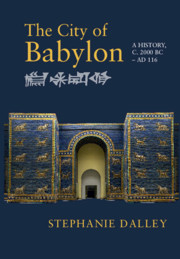Book contents
- The City of Babylon
- The City of Babylon
- Copyright page
- Contents
- Illustrations and Maps
- Preface
- Conventions
- Timeline
- Written Languages and Their Scripts
- 1 Land and Peoples
- 2 Discoveries and Excavations
- 3 First Kings to the End of the Great Rebellion, c. 1894–c. 1732
- 4 Law, Education, Literature, and the Path to Supremacy
- 5 From the Great Rebellion to the End of the First Dynasty, c. 1732–1592
- 6 The Next Six Centuries
- 7 In the Shadow of Assyria, 978–625
- 8 Empire
- 9 From the Death of Nebuchadnezzar II to the Death of Cambyses, 561–522
- 10 Darius I to Alexander, and Seleucid to Parthian Rule
- 11 First Parthian Conquest, 141 BC, to the Visit of Trajan in AD 116
- Appendix: Genesis 14:1–16 and Possible Links with Foreign Rulers Early in the Reign of Hammurabi
- Bibliography
- Index
3 - First Kings to the End of the Great Rebellion, c. 1894–c. 1732
Published online by Cambridge University Press: 23 June 2021
- The City of Babylon
- The City of Babylon
- Copyright page
- Contents
- Illustrations and Maps
- Preface
- Conventions
- Timeline
- Written Languages and Their Scripts
- 1 Land and Peoples
- 2 Discoveries and Excavations
- 3 First Kings to the End of the Great Rebellion, c. 1894–c. 1732
- 4 Law, Education, Literature, and the Path to Supremacy
- 5 From the Great Rebellion to the End of the First Dynasty, c. 1732–1592
- 6 The Next Six Centuries
- 7 In the Shadow of Assyria, 978–625
- 8 Empire
- 9 From the Death of Nebuchadnezzar II to the Death of Cambyses, 561–522
- 10 Darius I to Alexander, and Seleucid to Parthian Rule
- 11 First Parthian Conquest, 141 BC, to the Visit of Trajan in AD 116
- Appendix: Genesis 14:1–16 and Possible Links with Foreign Rulers Early in the Reign of Hammurabi
- Bibliography
- Index
Summary
The First Dynasty, an unbroken succession of Amorite kings, lasted 300 years despite a major rebellion. Babylon had close relationships with the nearby cities Sippar, Kish, and Borsippa. Trade and alliances reached much further. The Sumerian king-lists of earlier times were replaced by Babylonian equivalents, various cities having their own version. Kings briefly recorded major events; names were given to each year of their reign for dating documents. Trade was widespread, by canal and river, or overland by donkey. Royal edicts excluded certain groups from trade. Evidence comes from a profusion of clay tablets. Official letters are plentiful. Priestesses of Marduk carried out trade for Babylon in other cities. The temple of Marduk was built and furnished with a golden throne. Elamite control over several major cities, which left its mark on temple design, was ended by Hammurabi late in his reign; there is a possible connection with Genesis 14:1–16. Regular edicts were issued to release individuals from debt and to regulate trade. The main powers were Halab (Aleppo), Eshnunna, and Larsa, until Hammurabi achieved supremacy and claimed divinity. His successor Samsu-iluna followed his father’s example.
Keywords
- Type
- Chapter
- Information
- The City of BabylonA History, c. 2000 BC – AD 116, pp. 48 - 76Publisher: Cambridge University PressPrint publication year: 2021

